Kansas is full of captivating natural wonders and one of the most interesting are its mushrooms. Mushrooms have a long history in Kansas, and have been used for centuries for culinary purposes.
They can be found all over the state in a variety of different habitats, from woodlands to grasslands to even urban areas. The beauty and diversity of these fungi is astonishing, ranging from small edible mushrooms to impressively large mushroom-forming fungi such as bracket fungi and puffballs.
Common mushrooms in Kansas include stinkhorns, morels, honey mushrooms and oysters. Below we’ll discuss both edible and inedible fungi in KS.
List of Edible Mushrooms in Kansas
1. Oyster Mushrooms (Pleurotus ostreatus)
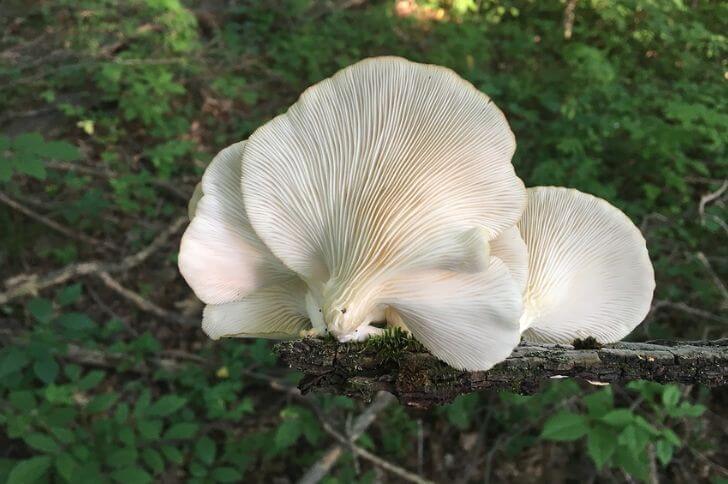
Oysters are some of the most common edible white mushrooms in North America. They are also found in the Kansas wild.
Scientifically called pleurotus ostreatus, this edible fungus appears in October to the first weeks of April.
It grows on dead or living hardwoods and at times conifers. However, telling it apart from other members of the pleurotus family can be challenging, but for proper ID check for:
Firstly, look out for its appearance. The caps of this oyster variety have the typically fan-shaped cap associated with oyster mushrooms. The cap can grow to almost 11.7 inches and have a smooth texture.
To tell them apart from others, this oyster variety tends to have a darker colored fan. Yes, it’s grayish-brown but darker. Gills are white.
Another important feature to note is the stem of the mushroom. It is usually short, almost non-existent, and thick with a whitish coloration.
2. Ringless Honey Mushrooms (Desarmillaria caespitosa)
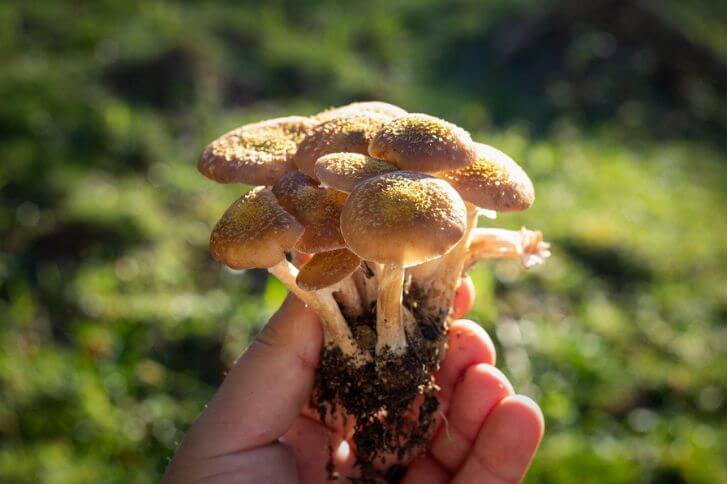
The Armillaria genus is known for its brown mushrooms that grow in tight clusters. Once called armillaria tabescens, ringless honey mushrooms have been recognized as a separate species and renamed desarmillaria caespitosa.
These Kansas mushrooms appear in late summer lasting through fall. They appear a few weeks before other honeys (armillaria mellea)
With their golden-brown caps and distinctive rings on the stems, they have become a popular ingredient for cooking enthusiasts who want to add a unique flavor and texture to their dishes.
The cap of the mushroom is smooth and slightly convex. Surface is dry compared to the armillaria mellea that has a sticky surface. The gills underneath the cap are well spaced and white at first but gradually turn pink-brownish as the mushroom matures.
3. Brain Puffball (Calvatia craniiformis)
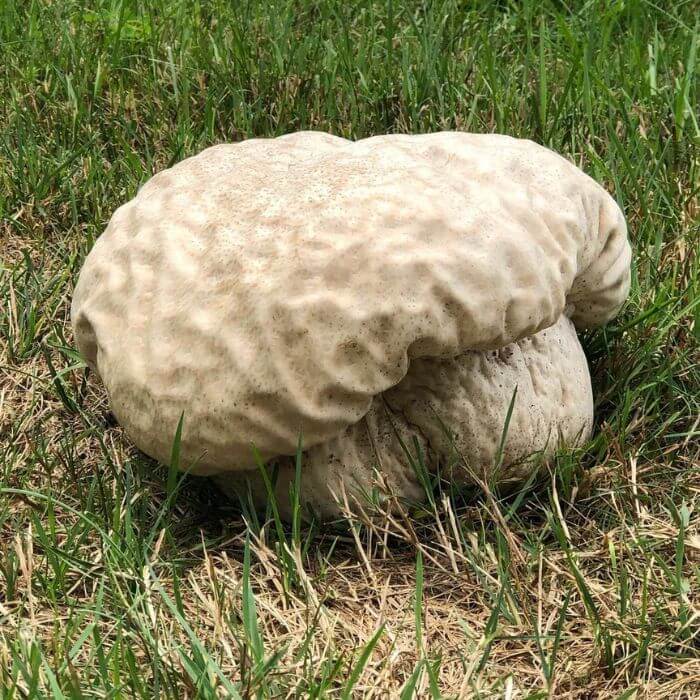
source: taranatula
Are brain puffballs edible? Yes. Often found on grassy areas, these puffballs are fascinating organisms whose unique structures resemble small white balls.
The body of this puffball typically measures about 1.9-5.9 inches wide but larger fruiting bodies have been observed.
When should you harvest brain puffballs? Young, all-white mushrooms taste better. Their flesh should be firm. Also note, puffballs absorb water so to clean just wipe and then pan fry.
4. Morels
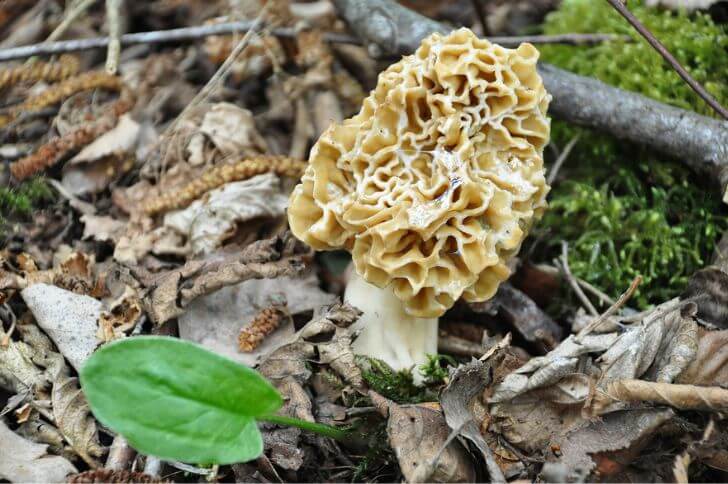
Are there morels in Kansas? Yes and according to KDWPT there are three common varieties:
Yellow morels: Are lighter in color and have a random honeycomb pattern
White morels: This variety also sports a honeycomb appearance. They grow on decaying organic matter and may be found away from trees unlike other morels.
Black morels: These are darker with canonical caps. Honeycomb pattern is more systematic with pits and ridges running down the cap.
Where should one forage for morels in Kansas? According to KDWPT, foragers should stick to state parks. Also, since the use of vehicles is restricted, we recommend you get hiking shoes so you can access inside the parks.
Morels usually appear in Kansas during the last weeks of March to the first weeks of May.
5. Turkey Tail Mushrooms (Trametes versicolor)
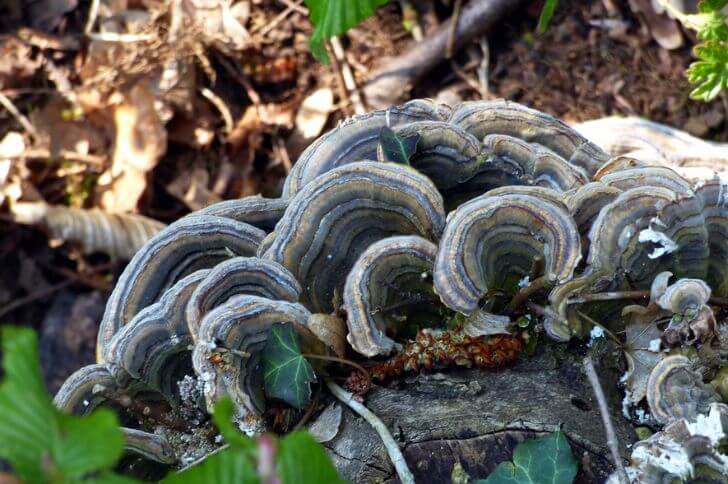
Trametes versicolor is a common bracket fungus found all over North America. Also called turkey tail, this shelf fungus’ fruit body has a colorful appearance resembling the feathers of a wild turkey.
How can you identify turkey tail from other shelf fungi? To confirm the identification look at the size of their body. It can measure anywhere from 1-4 inches across and has a distinctive fan shape.
The cap has distinctive bands of vibrant colors, ranging from cream, orange, brown, and yellow. Like other shelf fungi, turkey tails do not have stems. These mushrooms in Kansas are inedible however for centuries turkey tails have been used in teas and soups and in recent times foragers have been using them in smoothies.
Related Read: Common Nebraska Fungi
6. Sulphur Shelf Mushrooms (Laetiporus sulphureus)
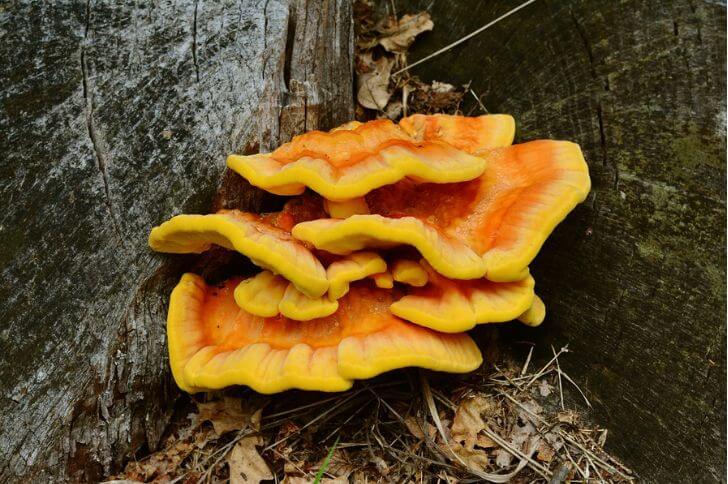
Considered edible while young sulphur shelf mushrooms are common in the United States. Also called chicken of the woods, these mushrooms in Kansas are liked due to their meaty texture and rich flavor.
The first step in identifying sulphur shelf mushrooms is to look for their bright orange or yellow coloration. These vibrant hues make the mushroom easy to spot from a distance. Additionally, the cap of the mushroom typically grows in overlapping layers or shelves, which gives it its distinctive appearance.
Another key characteristic of chicken of the woods is their pale yellow pore surface which produces a whitish spore print. When cooked properly, these mushrooms can have a texture similar to chicken or pork.
7. Chanterelles
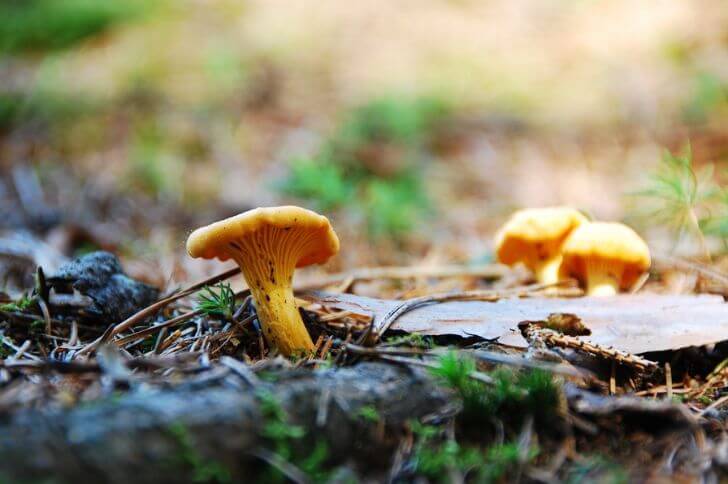
Kansas is home to a variety of fungi including chanterelles. Varities include
Golden chanterelles: These golden-yellow chanterelles have a distinctive fruity aroma, which can help distinguish them from other mushrooms. They also have a trumpet-shaped cap with wavy edges, and the underside of the cap has ridges instead of gills.
Cantharellus minor: This is the smallest member of the chanterelle species. It measures about 0.2-1.2 inches in diameter. The cap is often funnel-shaped and has a distinctive wavy edge. The colouration of C.minor varies but it generally has shades of yellow-orange.
Craterellus tubaeformis: Commonly called the Yellowfoot, this fungus has an earthy aroma and a slightly fruity taste, making it a popular ingredient in various dishes. Its color varies from yellowish to brown with ridges that run down the underside.
Black trumpet mushrooms: This chanterelle variety has a distinctive funnel or trumpet shape. The caps of these mushrooms are usually between 1-4 inches wide and range from dark brown to black, often with a slightly lighter edge. Their stems are usually thin, hollow, and paler than the cap.
8. Indigo Milk Cap
Indigo milkcap is sought after for its delicious taste and vivid blue color. Also called the indigo milky or blue milk mushroom, its bright blue cap that ranges from 2-6 inches in diameter.
The cap surface turns gray and gets a depression at its center with age. The rest of its body, gills and stalk, are also blue and with age turn grayish. Like all milky mushrooms, when cut this blue fungus produces a milky substance that turns greenish. Also its flesh changes from blue to green.
What time of the year do these blue milk mushrooms appear? From June to November. Ensure to cook well.
9. Lion’s Mane
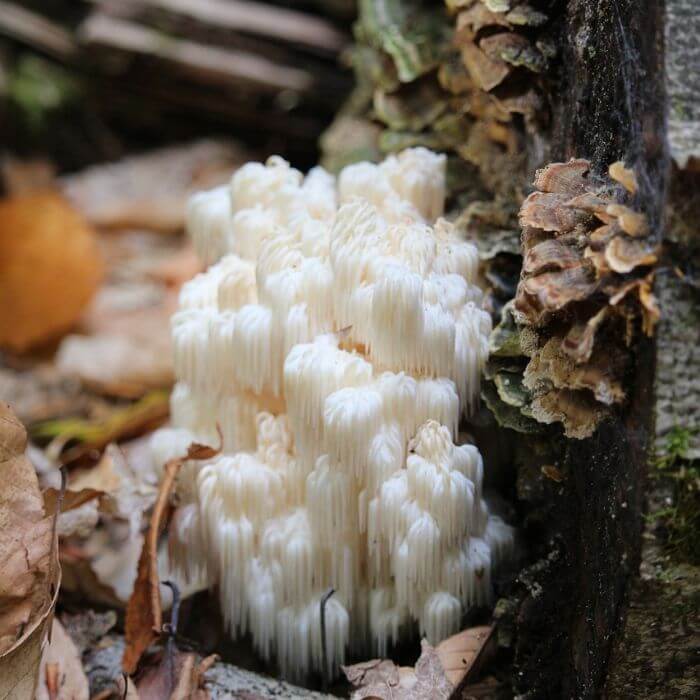
Do lion’s mane grow in Kansas? In the Sunflower state you can find the hericium erinaceus in late summer to fall and sometimes spring.
These white mushrooms in Kansas on living oaks in the wild. Also, due to advanced farming, you can grow them at home. Lion’s manes typically are white or cream-colored when young, and they grow in clusters that resemble pom-poms or lion manes.
As the mushrooms mature, they become more yellowish-brown in color and develop spines underneath their caps. The spines are soft to the touch and look like dangling icicles.
10. Witch’s Butter (Tremella mesenterica)
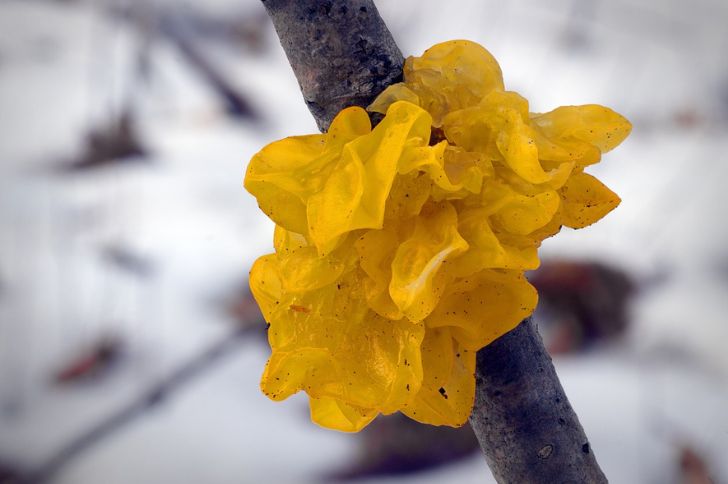
While it might not be the most striking Kansas mushroom to come across, witch’s butter is actually harmless and edible.
One of the easiest ways to identify witch’s butter is by its distinctive yellow-orange color and gelatinous texture.
The fungus has a smooth, rubbery appearance that can almost look like melted cheese or scrambled eggs. In terms of size, witch’s butter can range in size depending on the conditions in which it grows. Unfortunately this fungus is not tasty and most foragers ignore it.
11. Common Puffballs
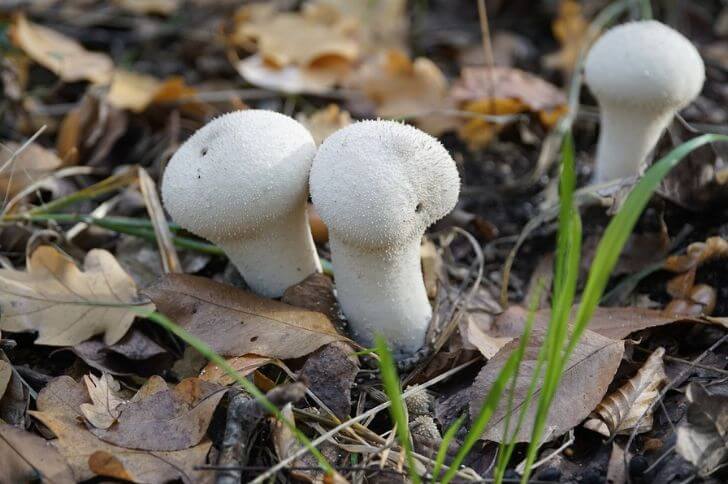
Common puffballs are … well, common. In Kansas you can find them in a variety of habitats including grassy areas, along roads and woods.
It is a small, pear-like mushroom that is white when young and transforms into olive-brown as it matures. The surface has small ‘spines’ or warts. When young, these white mushrooms can be eaten. Coat with breadcrumbs and fry.
Inedible Mushrooms of Kansas
12. Yellow-gilled Gymnopilus (Gymnopilus luteofolius)
The yellow-gilled gymnopilus are an inedible type of fungus in Kansas. It is a medium-sized mushroom with a wide brown cap and gills that are cream-buff and darken to rust-yellow as the mushroom matures. The stem of this fungus is usually fibrous and orangish-brown.
These brown-yellow mushrooms grow gregariously in wood chips of conifers and deciduous trees. They fruit in summer and fall. Yellow-gilled gymnopilus are bitter and inedible.
13. Stinkhorn
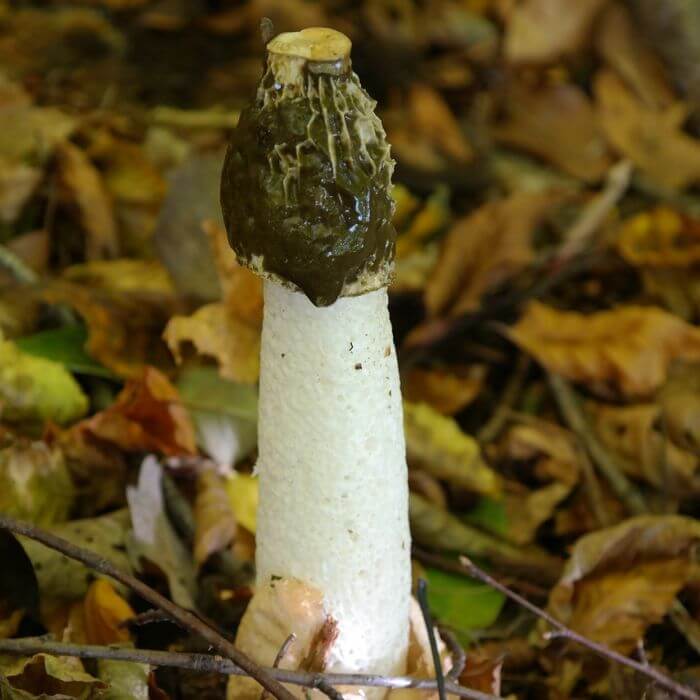
Stinkhorns are a group of fungi that have a characteristic foul odor, and they are known for their phallic shape. In Kansas you can observe:
Phallus rubicundus: One of the most distinctive features of Phallus rubicundus is its bright red stem that resembles a miniature tree trunk. The cap or head of this fungus is slimy and covered with spore-bearing tissue that gives off a pungent odor similar to rotting meat.
Common stinkhorn: These fungi also have a strong off-putting odor. The mushroom typically grows up to 11.8 inches tall and has a cap that resembles a bell or an eggshell. The surface of the cap is covered in greenish-brown slime which gives off a pungent smell that attracts flies and other insects.
Lantern stinkhorn: The most distinctive feature of the lantern stinkhorn is its pungent smell. It has been described as smelling like rotting meat or feces, which attracts flies that help disperse the spores of the fungus.
The lantern-shaped fruiting body, which can reach up to 5.9 inches in height, features a bell-shaped cap with an elongated stalk. The cap is usually reddish-orange and covered with a slimy substance.
If you come across these mushrooms while out on a hike or nature walk, it’s best to avoid touching them with your bare hands as their slime coating can cause skin irritation.
14. False Parasol (Chlorophyllum molybdites)
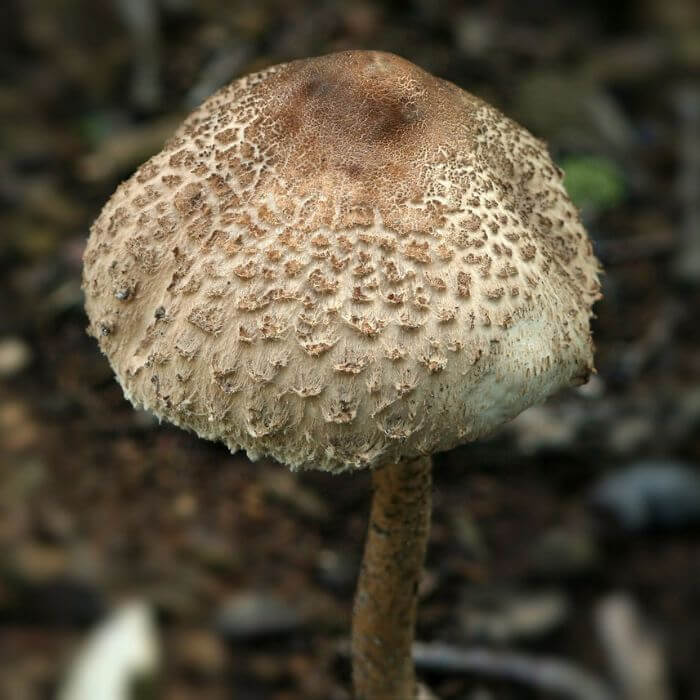
False parasols should be avoided at all costs. They are one of the most common lawn mushrooms in Kansas.
Also called the vomiter or green-spored lepiota, a lot of novice mushroomers confuse it for the button mushroom when young. As it ages, its cap opens up forming an umbrella-like shape.
The whitish cap of the false parasol measures up to 11.8 inches when fully mature. It also has distinctive pinkish brown scales that become more prominent as the mushroom matures. Underneath, the gills of the vomiter are closely spaced and start out white becoming green as it ages.
There is a prominent ring on their stipe. We recommend you avoid any lawn mushrooms.
15. Ganoderma Curtisii
Ganoderma curtisii is a species of mushroom that belongs to the Ganodermataceae family. The fungus grows on wounds of a variety of living hardwoods and on stumps and logs.
Caps grow up to 4.7 inches wide and sport a kidney shaped body. Their reddish-brown surface is shiny with a noticeable yellow margin. Underneath the pore surface is whitish, turning brown as they age. They grow individually or on top of each other.
Conclusion
Wild mushrooms can be a great addition to any meal, provided you know what to look for. If you are interested in foraging for wild mushrooms, be sure to do your research and consult an expert before consuming any fungi you find.
Additionally, purchase a reliable field guide that is specific to Kansas so you can identify the edible varieties accurately and safely. Remember that the best way to enjoy wild mushrooms is cooked.
source:
Hi There,
My name is Jenny. I’m the Chief Editor at Try Green Recipes and besides making yummy and healthy foods for my kids, grandkids, and friends. I’m new to the blogging world but I believe what I have to share is unique and will bring joy to your home. If you are adventurous and want try something tasty, let’s get started.

